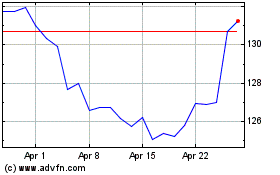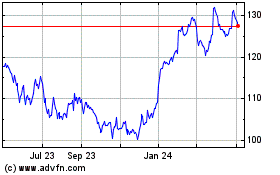Merck (NYSE:MRK), known as MSD outside the United States and
Canada, today announced the first Phase 3 study results for V212,
the company’s investigational inactivated varicella zoster virus
vaccine (VZV) for the prevention of herpes zoster or HZ, also known
as shingles, in immunocompromised patients. This was a
double-blind, randomized, placebo-controlled, multi-center trial to
study safety, tolerability, efficacy and immunogenicity of
inactivated VZV Vaccine in Recipients of Autologous Hematopoietic
Stem Cell Transplants (auto-HSCT). In the trial, V212 met its
primary endpoint and reduced the incidence of confirmed HZ cases by
an estimated 64 percent (95% CI, 0.48, 0.75) in recipients of
auto-HSCT. These results were presented today, as an oral
presentation, at the combined annual meetings of the Center for
International Blood & Marrow Transplant Research (CIBMTR) and
the American Society for Blood and Marrow Transplantation (ASBMT)
during a “Best Abstracts” session in Orlando, Florida.
Secondary endpoint findings from the study showed that V212
reduced the incidence of moderate-to-severe HZ pain by an estimated
69.5 percent, utilizing the Zoster Brief Pain Inventory (ZBPI)
score. V212 demonstrated an estimated 83.7 percent reduction of the
incidence of post-herpetic neuralgia (PHN) beyond 90 days after
onset of HZ. In the study PHN was defined as pain in the area of
the HZ rash with a “worst pain in the last 24 hours” score of 3 or
greater (on a 0 to 10 scale) on the ZBPI that persists or appears
90 days or beyond after HZ rash onset following auto-HSCT.
In addition, V212 showed reduction of other HZ complications by
an estimated 73.5 percent. These other complications included
hospitalization or prolongation of hospitalization due to HZ;
disseminated HZ (including disseminated HZ rash or VZV viremia);
visceral HZ, ophthalmic HZ; neurological impairment due to HZ; or
administration of intravenous acyclovir therapy for treatment of HZ
post auto-HSCT.
Because subjects receiving auto-HSCT are immunocompromised, they
are at six-times greater risk of developing shingles than the
general population. In 2014, an estimated 11,000 people underwent
stem cell transplantation in the United States. ZOSTAVAX ® (zoster
vaccine live), the only approved vaccine indicated for the
prevention of shingles in individuals 50 years of age or older, is
contraindicated in immunocompromised patients. ZOSTAVAX is not
indicated for the treatment of zoster or postherpetic neuralgia.
ZOSTAVAX should not be used for prevention of primary varicella
infection (Chickenpox).
“Patients undergoing auto-HSCT have an increased risk of HZ and
associated complications due to impaired cellular immunity. These
results indicate that V212 might offer a way to help reduce the
risk of HZ and HZ-related complications in this vulnerable,
immunocompromised patient population,” said Eliav Barr, M.D.,
senior vice president, Merck Research Laboratories. “We look
forward to exploring these data further and to reviewing the
results of an additional Phase 3 study that is underway in
immunocompromised patients with malignancies.”
About the Study (NCT01229267)
The Phase 3 randomized, double-blind, placebo-controlled,
multi-center trial included patients 18 years or older, undergoing
auto-HSCT for malignancy or any other indication, with a history of
varicella infection and/or seropositive for VZV antibody. Subjects
had no malignancy with more than two disease relapses (except
Hodgkin lymphoma), no planned tandem transplants, no previous VZV
vaccination, no HZ infection within the previous year, and no
intended antiviral prophylaxis for >6 months after auto-HSCT
(antiviral prophylaxis for <6 months was allowed).
Eligible subjects (n=1,230) were randomly assigned to receive a
4-dose regimen of V212 from a consistency lot (a lot having a
targeted potency as required by regulators in order to demonstrate
that the vaccine can be manufactured consistently), a high-antigen
lot (a lot having a higher antigen potency added to assess further
the safety profile of V212), or placebo. Randomization was
stratified by age (younger than 50 years vs. older than 50 years)
and by intended duration of post-transplant antiviral prophylaxis
(≤3 months vs. >3 to 6 months).
Dose 1 of V212 or placebo was given within approximately 30 days
before auto-HSCT, and doses 2, 3, and 4 were given approximately
30, 60, and 90 days after auto-HSCT. Subjects were followed for the
duration of the study for efficacy with cases of HZ confirmed by
PCR and/or adjudicated by a blinded data monitoring committee. The
average follow-up time for HZ surveillance was approximately 2.3
years (median: 2.6 years) post vaccination.
The most common systemic adverse events observed in both the
vaccine and placebo arms of the study at a incidence rate of 15
percent or more in either group, included diarrhea, nausea,
pyrexia, mucosal inflammation, thrombocytopenia, febrile
neutropenia, vomiting, anemia, neutropenia, decreased appetite,
fatigue, hypokalemia, and constipation.
Serious adverse events occurred in 216 (32.9%) subjects
receiving the consistency lot or high-antigen lot and in 181
(32.7%) subjects receiving placebo for up to 28 days after the
fourth vaccination dose. The most frequent serious adverse event
observed was febrile neutropenia observed in 5.3 percent of the
vaccine group and 4.9 percent in the placebo group. Serious
vaccine-related adverse events occurred in 5 (0.8%) subjects
receiving consistency lot or high-antigen lot and in 5 (0.9%)
subjects receiving placebo.
About V212
V212 is Merck’s investigational inactivated VZV vaccine for the
prevention of HZ and HZ-related complications in immunocompromised
subjects age 18 years and above. The Phase 3 trial in auto-HSCT
recipients has been completed. Another Phase 3 trial in subjects
with malignancies is ongoing.
About ZOSTAVAX® (zoster vaccine live)
ZOSTAVAX is a live attenuated virus vaccine indicated for
prevention of herpes zoster (shingles) in individuals 50 years of
age and older. ZOSTAVAX is not indicated for the treatment of
zoster or postherpetic neuralgia. ZOSTAVAX should not be used for
prevention of primary varicella infection (Chickenpox).
Select Safety Information
Vaccination with ZOSTAVAX does not result in protection of all
vaccine recipients.
ZOSTAVAX is contraindicated in: persons with a history of
anaphylactic or anaphylactoid reaction to gelatin, neomycin, or any
other component of the vaccine; persons with a history of primary
or acquired immunodeficiencies; persons on immunosuppressive
therapy; pregnant women or women of childbearing age.
A reduced immune response to ZOSTAVAX was observed in
individuals who received concurrent administration of PNEUMOVAX®23
(Pneumococcal Vaccine Polyvalent) and ZOSTAVAX compared with
individuals who received these vaccines 4 weeks apart. Consider
administration of the two vaccines separated by at least 4
weeks.
Serious vaccine-related adverse reactions that have occurred
following vaccination with ZOSTAVAX include asthma exacerbation and
polymyalgia rheumatica. Other serious adverse events reported
following vaccination with ZOSTAVAX (zoster vaccine live) include
cardiovascular events (congestive heart failure, pulmonary edema).
Common adverse reactions occurring in ≥1% of vaccinated individuals
during clinical trials include injection-site reactions (erythema,
pain/tenderness, swelling, hematoma, pruritus, warmth) and
headache.
Transmission of vaccine virus may occur between vaccinees and
susceptible contacts.
Deferral should be considered in acute illness (for example, in
the presence of fever) or in subjects with active untreated
tuberculosis.
About Merck
For 125 years, Merck has been a global health care leader
working to help the world be well. Merck is known as MSD outside
the United States and Canada. Through our prescription medicines,
vaccines, biologic therapies, and animal health products, we work
with customers and operate in more than 140 countries to deliver
innovative health solutions. We also demonstrate our commitment to
increasing access to health care through far-reaching policies,
programs and partnerships. For more information, visit
www.merck.com and connect with us on Twitter, Facebook, YouTube and
LinkedIn.
Forward-Looking Statement of Merck & Co., Inc.,
Kenilworth, N.J., USA
This news release of Merck & Co., Inc., Kenilworth, N.J.,
USA (the “company”) includes “forward-looking statements” within
the meaning of the safe harbor provisions of the U.S. Private
Securities Litigation Reform Act of 1995. These statements are
based upon the current beliefs and expectations of the company’s
management and are subject to significant risks and uncertainties.
There can be no guarantees with respect to pipeline products that
the products will receive the necessary regulatory approvals or
that they will prove to be commercially successful. If underlying
assumptions prove inaccurate or risks or uncertainties materialize,
actual results may differ materially from those set forth in the
forward-looking statements.
Risks and uncertainties include but are not limited to, general
industry conditions and competition; general economic factors,
including interest rate and currency exchange rate fluctuations;
the impact of pharmaceutical industry regulation and health care
legislation in the United States and internationally; global trends
toward health care cost containment; technological advances, new
products and patents attained by competitors; challenges inherent
in new product development, including obtaining regulatory
approval; the company’s ability to accurately predict future market
conditions; manufacturing difficulties or delays; financial
instability of international economies and sovereign risk;
dependence on the effectiveness of the company’s patents and other
protections for innovative products; and the exposure to
litigation, including patent litigation, and/or regulatory
actions.
The company undertakes no obligation to publicly update any
forward-looking statement, whether as a result of new information,
future events or otherwise. Additional factors that could cause
results to differ materially from those described in the
forward-looking statements can be found in the company’s 2015
Annual Report on Form 10-K and the company’s other filings with the
Securities and Exchange Commission (SEC) available at the SEC’s
Internet site (www.sec.gov).
Please see Prescribing Information for ZOSTAVAX at
https://www.merck.com/product/usa/pi_circulars/z/zostavax/zostavax_pi2.pdf
and Patient Information for ZOSTAVAX at
http://www.merck.com/product/usa/pi_circulars/z/zostavax/zostavax_ppi.pdf.
View source
version on businesswire.com: http://www.businesswire.com/news/home/20170224005651/en/
MerckMedia:Pamela Eisele, 267-305-3558orSkip Irvine,
267-305-0338orInvestors:Amy Klug, 908-740-1898orMichael DeCarbo,
908-740-1807
Merck (NYSE:MRK)
Historical Stock Chart
From Mar 2024 to Apr 2024

Merck (NYSE:MRK)
Historical Stock Chart
From Apr 2023 to Apr 2024
